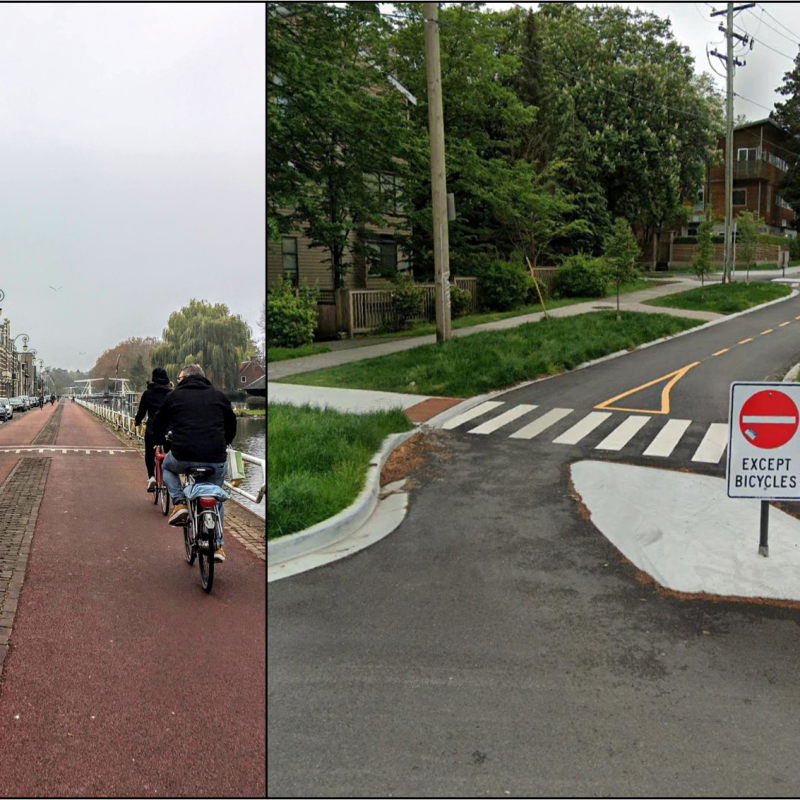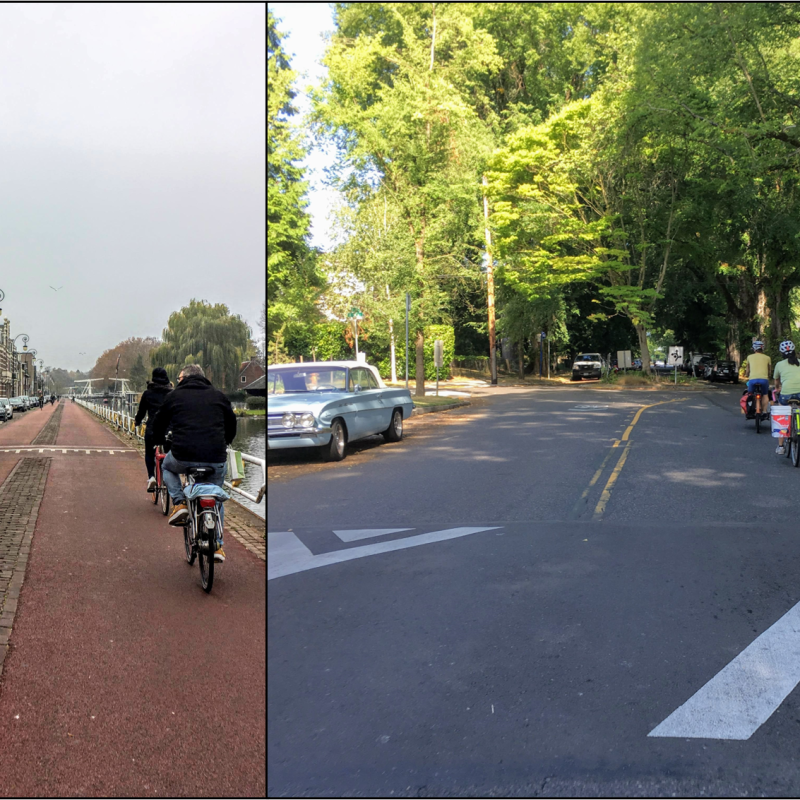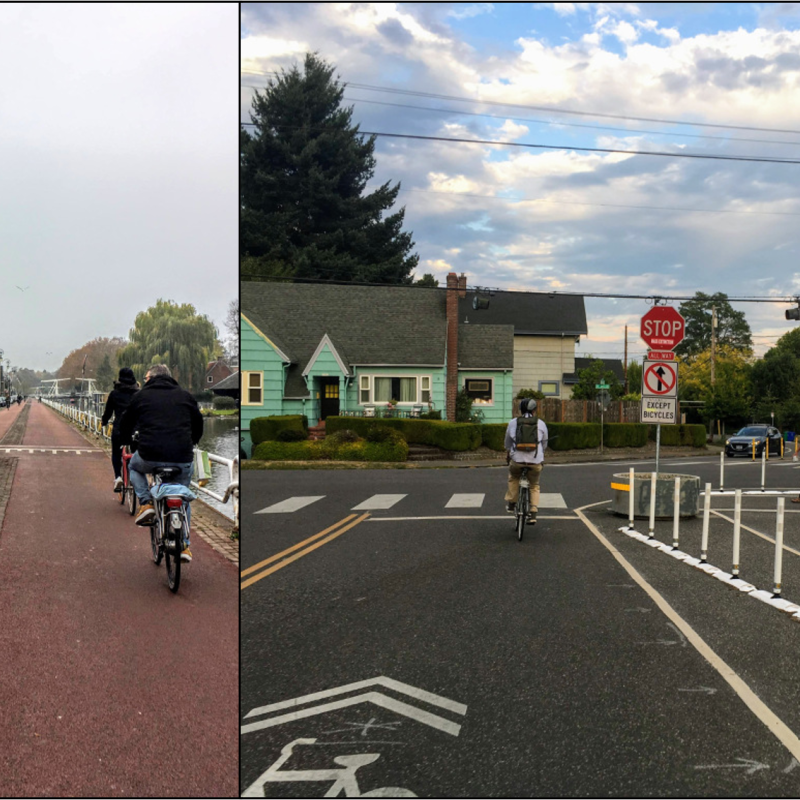Bicycle Streets Beyond Europe is a weekly multi-part series exploring the “bicycle street”. The first post overviewed the Dutch implementation of the bicycle street (“fietsstratten”) and the next several are showcasing some of the best examples of bicycle streets in Canada and the US. Special thanks to Justin Jones for contributing to this post. Join the Beyond the Automobile mailing list to stay up to date with the series.
Toronto’s Shaw Street is the envy of neighbourhood bikeway advocates everywhere.
Stand on a corner during the morning peak and you will see hundreds of cyclists quietly cruising along this seemingly insignificant street in the city’s west end. Motor vehicles are there too, but they are dwarfed by the volume of bikes; during an October morning peak period in 2019, the City measured 2.5 bicyclists for every motorist using the street. There are few streets in Canada and the US where bikes so grossly outnumber cars.
The Shaw Street bikeway was opened in 2013 with the addition of contra-flow bicycle lanes to a street that was mostly one-way for cars, enabling the street to carry two-way bike traffic. This intervention was a resounding success, more than doubling the daily volume of bike traffic to 1,341 cyclists per day by 2014. While the number of people cycling improved, the behaviour and attitudes of people driving frequently didn’t. City of Toronto data showed that a significant portion of vehicle trips on Shaw was cut-through traffic rather than local trips. People on bikes frequently reported being passed in the shared lane unsafely as people driving still viewed this route as a shortcut.

Despite the challenges, bicycle volumes continued to grow during the bikeway’s first six years in operation as Toronto added new routes that connected to Shaw, and by 2019, the volume of daily cyclists hit 3,000.
In 2020, piggybacking off a planned road resurfacing, the City implemented changes at the north end of Shaw with the goal of reducing the peak hour motor vehicle volumes from the current 180 to below 75, their maximum target for a shared lane. After a round of community consultations, the one-way configuration of the street was altered so that instead of being consistently one-way southbound, it alternated between southbound and northbound every few blocks. The goal: a street that discourages cut-through driving and improves comfort for the high proportion of people nearby who walk and cycle.

Is it a Bicycle Street?
- Network: the route serves a key role in Toronto’s cycling network, connecting to many high-volume east-west cycling routes and providing one of the only continuous north-south routes in the area. In the near term, Shaw is due to be connected to Winona to form part of the Major City Wide Cycling Routes. The Shaw-Winona Corridor is the only local street route that is part of that important network.
- Volumes: bicycle volumes are over 3,000 per day, and greatly exceed the volume of motor vehicles. With the recently-implemented changes, motor vehicle volumes should be well below the 2,500 upper daily limit adopted by the Dutch.
- Speed: the speed limit is 30 km/h and this is reinforced through frequent speed humps.
- Design: the street is 7.2m between curbs with one lane of parking and a 5.3m wide travelled portion consisting of a 3.3m shared lane and a 2.0m contra-flow lane. This narrow travelled portion of the street makes it intentionally more difficult for motorists to pass cyclists, and is close to the Dutch target for a travelled way of 4.5 to 5 metres.
- Behaviour: the explosive growth in cycling on this important route is an indicator of its success. And yet, from some visits to this facility, it appears that cyclists don’t feel entirely empowered to “take the lane” when riding in the direction shared with vehicles, and many prefer to ride at the side of the lane, in the door zone of parked cars. The City has recently added “Single File” signage to reinforce to people driving that they should not be passing people on bikes, but that message may also discourage riders from engaging in social cycling – the simple and pleasurable act of riding side by side and carrying on a conversation.

Even with textbook implementation of new infrastructure, behaviour is hard to change. Shaw Street is somewhat of an outlier in Toronto’s bike network (at least at the time of this writing), so there may yet be work to do when it comes to changing the behaviour of people driving on this street. At the end of the day though, Toronto has done many things right to enable this street to function as a bicycle street, and if this design approach can be replicated more broadly, the road user culture will hopefully change with it.
Finally, we applaud the data-driven approach taken by Toronto on this project. When producing and assessing options, Toronto used multiple datasets including volumes of motorists, cyclists, and pedestrians at all times of day, on-street parking utilization, and origin-destination data to determine how much motor vehicle traffic was “cut-through” traffic. The City then identified a plan to measure the project’s success, and within a year will return to Shaw to observe new user behaviour and collect new traffic counts. Hopefully the post-implementation results will provide the precedent that Toronto (and other communities) need to implement changes like this more broadly.
Special thanks to Justin Jones for collaborating on this post. Justin is an active transportation and community engagement professional who works to create communities where transportation is a joy, not a chore. He works to expand access to public spaces for everyone, regardless of how they choose to get around. You can find him on Twitter.
Don’t forget to check out the other posts in the Bicycle Streets Beyond Europe series below.








What is the maximum daily cyclist volume that Shaw can handle?
That’s a tricky question. It breaks down to,
At what part of the day will this street be completely saturated? Would it be at 7am? 8am? And when will volumes go down? 10pm?
Will there be times with more cyclists going in one direction than the other, so they spill over into the oncoming lane?
So what is the most number of cyclists that Shaw can handle for one hour or at a given moment?
And would the maximum daily cyclist volume on Shaw be 10,000 cyclists? Would it be more? 15,000? If so, how does that affect how we see the Bloor/Danforth bike lanes? College? Dundas? Martin Goodman Trail?
Now, the question will be, who is in charge with filling Toronto bike lanes, so we get authorized to ask for more bike lanes? The biggest reason for not building bike lanes is they don’t get used. But their capacity is pretty high.
LikeLike